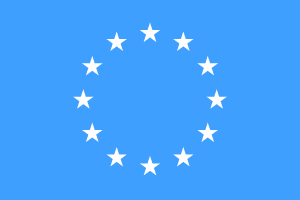BY LETTER
Europe
Galactography > Places and Locales
Galactography > Other Major Polities, Empires, and Meta-Empires > Solsys Organisation
Galactography > Other Major Polities, Empires, and Meta-Empires > Solsys Organisation
 Image from The Astronomer | |
| The flag of the European Federation, a modified form of the earlier European Union flag | |
A continent, or according to some geographers a subcontinent, on Old Earth. It is bounded by Asia, the Atlantic Ocean, the Arctic Ocean, and the Mediterranean Sea. Europe is the world's second-smallest continent by surface area, covering about 10,180,000 square kilometres, but a very large percentage of arable land, a complex coast line, and proximity to some of the oldest centres of human civilization gave it a large population density and a disproportionate impact on human history on Old Earth, especially since it was the first region on the planet to enter the Industrial Age.
Given its proximity to Africa, Europe was home to the human species since a time very close to the origin of humanity itself. The Agricultural Age opened early with the diffusion of domestic animals and plants and farming techniques from southwest Asia. This led to a vigorous and distinctive European/North African/West Asian metaculture, comparable in power and diversity to those of the Far East or the Indian Subcontinent. It was centred first in southeast Europe and later the entire Mediterranean; cities such as Athens and philosophers such as Aristotle are remembered to this day. Later, the European cultural scope expanded to include major northern European polities and the European collection of cultures took on a distinctively Christian world view. This eventually gave rise to the earliest outbreak of Industrial Age technologies and to what was to become known as 'Western' culture. European polities were predominant in world affairs from about the 5th century BT onwards, and European immigrants and ideas completely or almost completely overwhelmed the indigenous cultures of three other continents (North America, South America, and Australia) while European impact transformed local cultures and polities of Africa, and even eclipsed local powers and irreversibly altered the course of history in the larger Eurasian continent. European sciences and technologies, European arts, European languages, and the distinctively European version of Christianity achieved worldwide distribution.
Though it was later overshadowed by the rise of derived European-descended cultures and polities from former colonies, and by the resurgent power of Asian, and later African, cultures and polities, European cultural, political and economic influence remained strong even into the Interplanetary Age, though together with all of Old Earth's regions Europe declined in influence with the rise of offworld powers (many of which, however, were of European origin). As early as the Information Age the importance of individual European states declined with the rise of regional metanational powers such as the European Union, though the region generally remained prosperous and influential. In 97 AT, after decades of gradual integration (despite occasional setbacks) and a series of reforms, the European Union officially became the European Federation.
 Image from Steve Bowers | |
| EuroFed flag in the Last War era | |
The Technocalypse, the Last War and the Great Expulsion effectively ended European history, as it ended history all across Old Earth, but the wave of European refugees gave a final and powerful boost to Europe's heritage in Solsys and in the early interstellar colonies.
Recognizably European-derived cultures and polities are numerous and varied, including such groups as the Kontore League, an interstellar colonisation venture that founded Nathan and Danzig among other worlds. Many nearbaseline groups today have, out of custom or sentiment, retained variations on old European cultures and physiotypes.
Since the Great Expulsion Europe has been restored to a level of ecological diversity it had not seen since the Pleistocene, with lions in the forests of Greece and wisent, mastodons, and aurochs on the coastal plains of Germany. As with once densely-settled regions of Old Earth, a large number of cultural sites have been restored or re-created by GAIA or her agents, and some of these are open to visitors. The rather thin population includes not only baseline/nearbaseline humans but lazurogened neanderthals and various rianths and provolves.
Related Articles
- Academion
- Africa
- Antarctica (Antarctic Free States)
- Asia
- Athens, Greece
- Australia
- Continent (geography)
- Continent (geology)
- Danzig
- Lyonesse
- Nadia
- Nathan
- North America
- Old Earth
- South America
- United Kingdom (Britain)
- Vatican City - Text by M. Alan Kazlev
Old Earth city state and capital of the Catholic Church. Much of Vatican City was packed in inert gas and put in a diamondoid vault, thus escaping the Technocalypse. Today it remains, in a vault surrounded by restored Mediterranean forests, one of the small number of pilgrimage sites of Old Earth.
Appears in Topics
Development Notes
Text by Stephen Inniss
Initially published on 20 June 2010.
Initially published on 20 June 2010.






